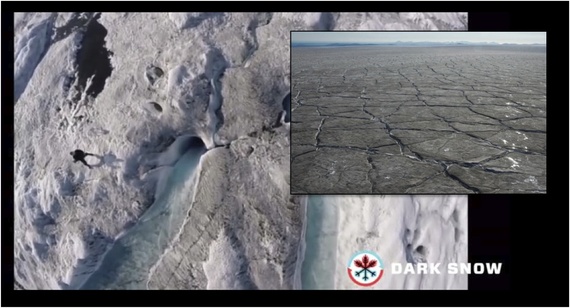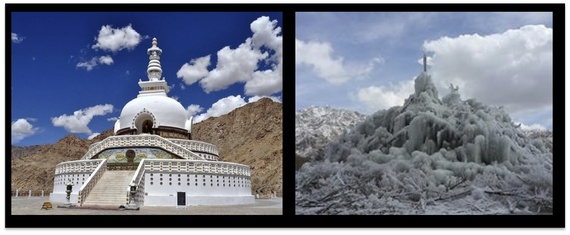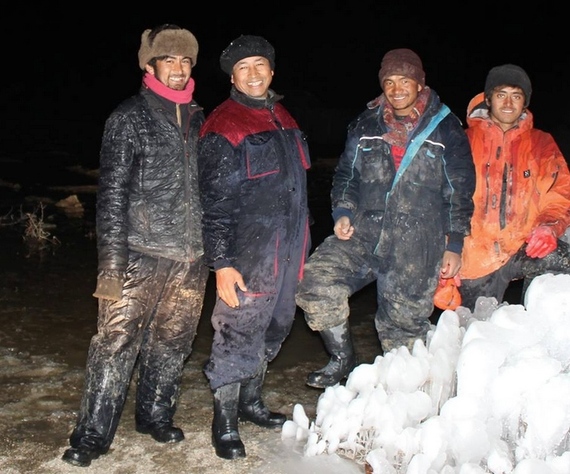Richard Branson, the founder of Virgin-everything, thinks crowdfunding is changing the world. And all sorts of products, from good wine to indy movies are getting enthusiastic financial support from the public these days.
So are innovators in science and energy just too wonky to reach out to the public? Not at all - it's looking like they may be just wonky enough. Here are three successful campaigns, each with its own short video by This Planet.
I. Crowdfunding Climate Science in the Far North
If the Greenland ice sheet took a couple of selfies, they would look like this:
The island has been covered by massive glaciers since time immemorial. The ancient sagas say that the Viking Erik the Red gave Greenland its name on purpose. He aimed to attract unwary settlers who would be put off if he had called it something more accurate - like "Whiteland."
Today Greenland still isn't green, but it is no longer white. The island is grey and brown. But why? That's what Glaciologist Jason Box wanted to know. Thanks to a successful crowdfunding campaign, Box found the answer, as featured in our This Planet video, "What Is Dark Snow?"
Pure science rarely goes to the public for money - maybe because the work scientists do can be hard to translate into plain English, let alone into exciting English. But Dr. Box is onto a hot topic. Plus, he's a digital native. And he is, well, photogenic. Box and his colleagues represent a new kind of scientist-activist, and may be the cutting edge of a new trend. As profiled in this 2013 article at Climate Desk, Box is determined to get out on the ice come hell or high water (literally):
Box increasingly began to think outside of...his last name. Rather than waiting on funding agencies, he teamed up with Greenpeace on a series of expeditions to document, and also dramatize, the ice sheet's melting.
And now the Dark Snow team has raised funds for a couple of drones, so they are mapping the changing glaciers with unprecedented accuracy.
II. Crowdfunding Solar Energy in the UK
The Brits have come up with a novel solution to building a solar-powered future. Abundance Generation lets you toss a couple of quid into the solar pot, so to speak. Here's a short video that explains how it works, produced when Abundance won an Ashden Award in 2015:
What an improvement on US crowdfunding! Abundance funders become legitimate investors who reap the rewards, while basking in the glory of doing the right thing. The US could use this idea, to counter the influence of utility companies in places like Nevada, a very sunny state where the Public Utilities Commission is trying to stop solar from cutting into its profit margins.
III. Crowdfunding Weird but Promising Innovations
One great thing about crowdfunding is that odd and quirky projects can find start-up money - and validation. Our favorite example of this is in the remote Himalayan state of Ladakh, where an energetic and brilliant engineer, Sonam Wangchuk, built the ice stupa. What's a stupa? More on that below - but first, in This Planet's video, Wangchuk tells the story of his invention to combat seasonal drought on the high plateau.
Their aim was to find a solution to the water crisis facing Ladakhi farmers in the critical planting months of April and May, before the natural glacial melt waters start flowing.
By February 2014 they had built a two-story prototype of an ice pyramid that could store roughly 150,000 liters of winter stream water, which otherwise would have gone to waste. They called it an Ice Stupa because the shape resembles traditional Buddhist shrines of Ladakh and Tibet, known as stupas:
Then they planted 5,000 trees, to be watered by the melting ice pyramid, and over 90% survived. Today they are working on improving the gravity water feed system after an accidental freeze-up this winter. Trial and error, brought to you by - you!
Please contribute to these projects:
Dark Snow: http://darksnow.org
Abundance Generation: https://abundanceinvestment.com/
Ice Stupa: http://icestupa.org
And if you know other great examples of crowdfunding breaking new ground - especially in science and tech - leave a comment below or send us an email.
----------------------------------------------------------------------



